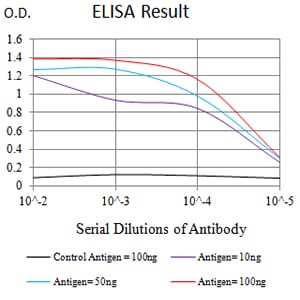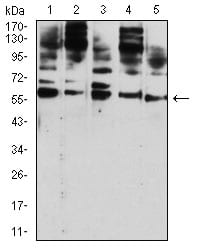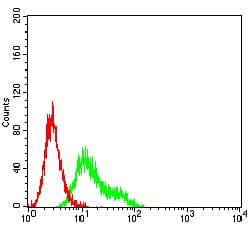


| WB | 1/500 - 1/2000 | Human,Mouse,Rat |
| IF | 咨询技术 | Human,Mouse,Rat |
| IHC | 咨询技术 | Human,Mouse,Rat |
| ICC | 技术咨询 | Human,Mouse,Rat |
| FCM | 1/200 - 1/400 | Human,Mouse,Rat |
| Elisa | 1/10000 | Human,Mouse,Rat |
| Aliases | CDSIGN; CLEC4L; DC-SIGN; DC-SIGN1 |
| Entrez GeneID | 30835 |
| clone | 5C2A6 |
| WB Predicted band size | 45.8kDa |
| Host/Isotype | Mouse IgG1 |
| Antibody Type | Primary antibody |
| Storage | Store at 4°C short term. Aliquot and store at -20°C long term. Avoid freeze/thaw cycles. |
| Species Reactivity | Human |
| Immunogen | Purified recombinant fragment of human CD209 (AA: extra 270-404) expressed in E. Coli. |
| Formulation | Purified antibody in PBS with 0.05% sodium azide |
+ +
以下是关于CD209(DC-SIGN)抗体的3篇代表性文献及其简要摘要:
---
1. **标题**:*DC-SIGN, a dendritic cell-specific HIV-1-binding protein that enhances trans-infection of T cells*
**作者**:Geijtenbeek, T.B., et al.
**摘要**:该研究首次揭示了DC-SIGN(CD209)在树突细胞介导的HIV-1传播中的关键作用。通过使用特异性抗体阻断实验,证明DC-SIGN与HIV-1包膜蛋白gp120结合,促进病毒向T细胞的转移,为靶向DC-SIGN的抗体治疗提供了理论基础。
---
2. **标题**:*Structural basis for selective recognition of oligosaccharides by DC-SIGN and DC-SIGNR*
**作者**:Feinberg, H., et al.
**摘要**:通过X射线晶体学结合抗体表位分析,解析了DC-SIGN的碳水化合物识别结构域(CRD)与病原体糖基化蛋白的相互作用机制,揭示了抗体靶向CRD可抑制病原体(如埃博拉病毒)与宿主细胞的结合。
---
3. **标题**:*DC-SIGN (CD209) mediates dengue virus infection of human dendritic cells*
**作者**:Tassaneetrithep, B., et al.
**摘要**:研究发现登革热病毒通过DC-SIGN感染人树突细胞,利用抗CD209抗体阻断实验证实该受体在病毒内吞中的必要性,为开发基于抗体或受体阻断的抗病毒策略提供了依据。
---
4. **标题**:*Targeting DC-SIGN via its carbohydrate recognition domain for anti-HIV therapy*
**作者**:Svajger, U., et al.
**摘要**:该文献探讨了针对DC-SIGN碳水识别结构域(CRD)的单克隆抗体在抑制HIV-1与树突细胞结合中的应用,通过体外实验证明特定抗体可显著降低病毒捕获和转运效率,提示其治疗潜力。
---
这些研究涵盖了CD209抗体的功能机制、结构基础及治疗应用方向。如需具体文献年份或期刊信息,可进一步补充检索关键词。
×